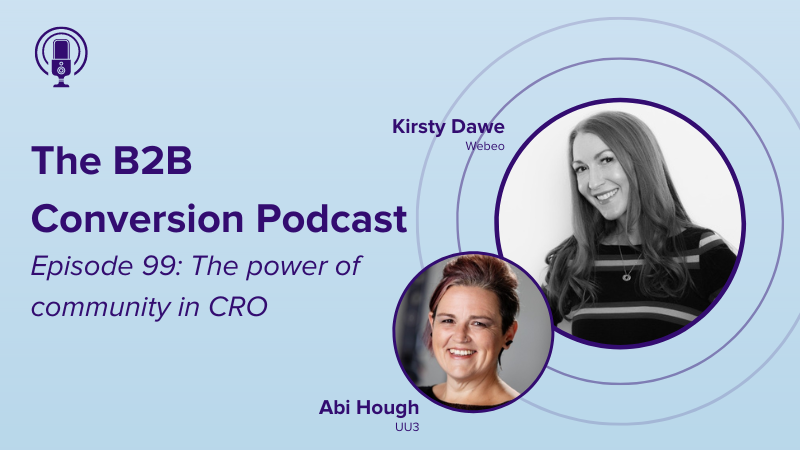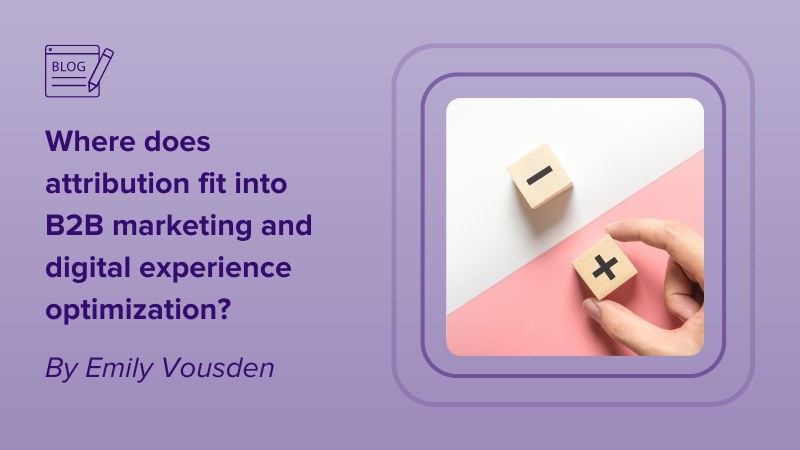Throughout 2023, we created a whole range of content from podcasts, webinars, and video testimonials. We’ve taken the best pieces of advice from every piece of content shared and put it together in one place to help you with your conversion rate optimization journey.
Website personalization
“A recognize me based experience like ‘Hi @Company Name’, doesn’t have a huge impact in B2B. But when you look at your data and make changes that can help your visitor find the information relevant to them you can drive them further through their journey. This is known as help me personalization.”
“You need to include personalization in your marketing strategy to operate in the market at any decent level.”
“There’s little value in just personalizing the homepage when every other page has a generic experience.”
“You need to look at the prospect’s journey on your site to understand their buying stage. Then you can create experiences based on giving them the rest of the information they need to convert.”
“Every job role and position in the funnel needs different information, therefore you need to feed each audience segment with the correct information for their role and stage to improve their chances of converting.”
Conversion rate optimization
“Your website needs to be the digital representation of your best salesperson. Is your website following the same conversation that the physical salesperson would have with a prospect? If it isn’t then you need to change it to follow suit and make it as logical as possible.”
“Your team needs to understand and have the mentality that CRO is not a one-off project. CRO needs to be a part of the core foundation that continues to develop and grow as the business does.”
“CRO is not an initiative, it should be a core part of marketing strategies. CRO cannot be left alone, it has to be constantly developing.”
“There is progress being made in B2B but until businesses get across that they need to be engaging to their prospects in a way that is relevant to them, they will struggle to advance their CRO strategy.”
“Marketers get excited about getting as granular as possible but with CRO they need to start wide and then go deep. Otherwise they’ll take a long time to start seeing results.”
“Microsoft found that out of all the ideas that could drive better results, 1/3 will make a positive impact, 1/3 will have no impact, and 1/3 will have a negative impact. Marketers should be talking more about these failures, as understanding how to use these failures for success is going to be vital as technology continues to accelerate.”
“Your website is the single point of contact for each of your channels. By optimizing your website you will in turn improve all marketing channels.”
AB testing/ Experimentation
“Different audiences will interact with your AB tests differently. You need to dive into each channels performance, then understand how your visitors interact with your website. This will give you a better picture of what’s happening with your conversion rates.”
“You need to leave your tests long enough to reach statistical significance. This means you’re above 95% sure that the test has reached a conclusion. To do this, run your test for 2 weeks and make sure you’re getting a minimum of 4,000 visits per test. If you don’t reach statistical significance in 2 weeks, you need to continue running the test.”
“Never assume your results, always test them. You need to validate the hypothesis and know that it’s right, otherwise it’s not true.”
Value proposition
“Creating a sales led value proposition is important if you want to sell through your website. The brand proposition won’t be the same reason that makes people buy, it will be the reason why people love the company – which is different.”
“Surveying your customers using a mixture of open and closed questions can give insight into how customers see your value compared to your competition. This will help you create a value proposition that will say ‘Hi, my ideal prospect, this is why you should buy from me and not my competitors’.”
Data
“Quantitative analysis can determine your page prioritization. You need to identify the pages which have the biggest impact, most footfall, and the highest growth opportunity. Score your pages from highest to lowest for each category, then focus on the pages that scored the highest as you know they will have the biggest impact.”
“There is some really easy stuff you can do in Google Analytics to get an idea of the pages you need to focus on optimizing. There’s 3 metrics you should judge your pages by – how much conversions are coming through those pages, how much traffic is going to those pages, and what is the current bounce rate.”
“Quantitative data will tell you where the problem is, but the qualitative data will tell you how to fix it.”
“Too many organizations are still making decisions based on the opinion from the HIPPO (highest paid person in the room), rather than based on data. Opinion only has a 50/50% chance of being right. Whereas if you listen to the data, by using AB tests to prove or disprove your hypothesis, it has been proven that you will grow faster than organizations following opinion based decisions.”
“To understand what changes need to be made in your CRO strategy you need to start looking at where people are clicking on the page, are they clicking CTA’s or are they starting to fill in forms and not finishing them? Looking at these things can help you understand user behavior so you can improve their experience on your site.”
“If you have a small customer base, low traffic, or are unable to conduct email surveys, there are some short cuts you can make to ensure you can still collect qualitative data. There are tools out there where you can pay people to test the UX of your site. You can give the demographics of the people you wish to test your site and then you can ask them questions to understand their opinion, helping to shape your CRO strategy.”
B2B vs B2C
“Behavioral personalization is huge in B2C, and we’re making a huge mistake not taking those learnings and applying them in B2B.”
“There’s a difference between B2B and B2C personalization. In B2B, personalization is more focused on seeing relevant information, helping you to establish trust. In B2C, personalization is used for improving customer satisfaction.”
“B2B buyers are consumers at heart, this means that there’s a lot of cross over in expectations. You can take what you know about B2C buying habits and apply them to the B2B buying cycle.”
Buyer intent
“Organic traffic is the most valuable traffic visiting your site. Many companies aren’t investing enough in SEO, especially considering their intent is higher than most, as they are already looking for your solution and are in middle to the bottom of the funnel. This group of traffic is a great opportunity to focus on converting more of.”
“Start by looking at the intent of your prospects, how did they get to your website and what journey have they already been through with your business. This will help you have more valuable conversations when the prospect lands on your site.”
Buyer journey
“You can’t just personalize the homepage and expect visitors to convert. Our buyers are much more savvy, they want to search around the site, find the answers to multiple questions they have, so they visit multiple pages. That’s why you should always personalize a minimum of 4 pages in each campaign.”
“More than 5 years ago, prospects were around 57% of the way through the B2B buying process when they spoke to a sales rep. Today they are likely to be 70-80% of the way through the buying process, which means they are spending more time on your website searching for the relevant information.”
“When prospects find it easy to find information that’s relevant to them they hang around for longer, they keep looking and they engage more.”
“So much brand value comes from online interactions. If you aren’t in control of those interactions, your prospects will just bounce off if they can’t find the information that they need and can’t take that purchase process all the way through.”
“When making any changes to your website or buyer journey, start with the customer in mind, and think about what is most convenient for your customer rather than how can I get them from A to B as quickly as possible.”
“Telling a story to each decision maker based on their job role, what they’re interested in, and what problem you’re solving for them can really help build relationships with your target audience.”
“Look at the customer journey and personalize the content based on where someone has come from, how they got to you, and what they are doing on your website. You can then understand the trends and triggers from your audience and use that data to optimize the customer journey. You’re then able to present some great personalization’s.”
“The error that people are making is that they’re only looking at isolated campaigns or interactions. You need to be looking at the entire journey and funnel to understand your data fully.”
“The businesses that win will be the ones that start to build out dynamic journeys.”
“The beginning part of someone’s journey with your brand can impact their renewal chance later on down the line. It’s super important to optimize the entire customer journey, so you can increase their customer lifetime value.”
“People are going to be doing a lot more research beforehand, you need to enable your marketing teams to build out the right journeys. They need to nurture leads as they come in and then generate the right insights for sales so they can follow up with them.”
ICP
“Understanding your ICP will enable you to build relevant and focused website experiences, as you understand your audiences needs, and where your product will fit in.”
Tech stack
“When implementing new tech, you need to make sure that you are direct and explicit with what you want this piece of technology to accomplish, otherwise the supplier won’t be able to help you get the results you need.”
“There are 3 things that a brand needs to consider when buying new tech and AI. 1. It’s a mindset change, stop treating everything you do as disposable. 2. Consistency, you’ve got to look at the results constantly, so you can understand how to optimize it to its full potential. 3. Budget, are you allocating the right amount of budget to optimize the new tech.”
AI
“Use Gen AI as the starting point not the finish line – used correctly alongside your own creativity is when it is most powerful.”
Getting started
“If you’re new to website personalization, start from the top with your biggest data group so you can start testing and get results faster.”
A massive shout out to Kirsty Dawe and Dawn Upton for hosting our podcast and webinars. Another huge mention goes to all of our guests for sharing so much knowledge and valuable insights in 2023, including – Richard Robinson, Phil Cave, Nick Mason, Jon Busby, and Louis Halton Davies.




